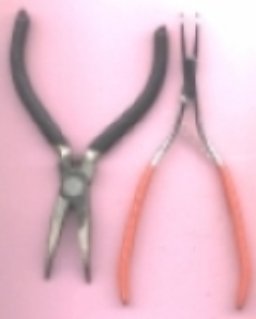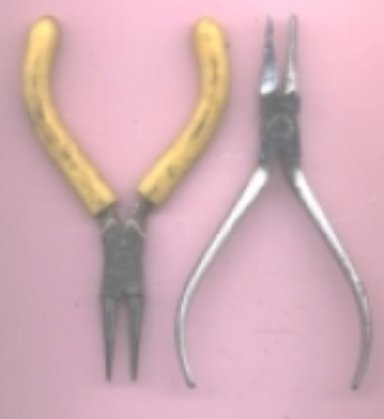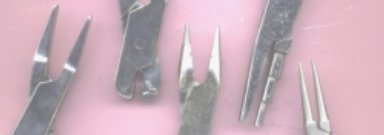For a firmer grip than tweezers, many pliers have similar, more robust, shapes, but for other specialized uses shapes vary to a greater extent. Due to their heavier tips, most are suitable for bending and shaping, while others are erroneously used as wrenches. Sizes vary from very fine to large bulky masses. Some are locking or clamping. All have a fulcrum, pivot joint between the jaws and grips to provide mechanical advantage. Less expensive ones have sloppier, lap joints, where the two halve are side by side by a pin. Better aligned and more rigid, are box joints, where one half fits in a slot in the other. Used commonly for adjustable jaw opening, the worst is the slip, lap joint with two or more incomplete circular holes in one half. The pin fastened to the other half has flats, which permit it to pass from one hole to the other through a narrow break in the circles, when fully opened. A much better arrangement is the arc joint with several teeth like meshing curves. More recently ratchet, self adjusting types have been introduced. Many variations exist with varying degrees of success. For serious work, good alignment and rigidity are essential.
In modelling sizes the variation of joints is basically limited to lap or box joints, with the latter preferred. Probably jaw shapes will be the prime selection factor, dependent on the job. For holding, flat faces, with or without superior gripping, more damage causing serrations are preferred. Jaw contours will vary according to need and fit. Jaws, pointed or thinned for tight access, provide less strength for bending purposes and tend to twist out of alignment, however they be quite useful for delicate bending. Shorter tapers are more rigid than longer, flatter ones. Soft handles on small sizes are an unwarranted luxury, unless you have tender fingers. Spring loaded opening may be an aid in some cases or a hindrance in others. A little practice will soon teach very adept, opening and closing with fingers only.

Note: Adjust brightness and contrast for optimum viewing.
SMALL, LONG OR CHAIN, NOSE PLIERS, SPRUNG
Xuron narrow jaw, flat joint, leaf spring
Maxon fine point, box joint, leaf spring (most used)
Pittburgh thick nose, lap joint, coil spring
Pittburgh flat, wide nose, lap joint, coil spring
S S needle nose. box joint, leaf spring
Sears long needle nose, lap joint, leaf spring
Noses may be bent up to about 90 ° for angular approach, where straight handles might prevent access. In some cases, a better grip on the part, for placement, may be yielded.

Note: Adjust brightness and contrast for optimum viewing.
BENT NOSE PLIERS
Pittburgh thick nose, 30 °, lap joint, coil spring
S S long needle nose, 45 ° box joint, leaf spring
(bends=bright areas at tips)
Many pliers are specifically designed for bending curves of all types, sizes and combinations. Tips may be conical, concave, convex, flat or odd complex shapes with different ones on opposite legs. Some are tapered or stepped, or a combination of both to permit different sized bends. Some bend very specific shapes for replication. Used by jewelers to bend intricate findings, by orthodontists for fabricating braces or plates and by others; often names are confusing dependent on the origin or source. An example is the 2 cone rosary, which was originally used to hand make rosary bead chains. It can easily produce S curves.
Several inexpensive and usable styles are found in hobbyshops.

Note: Adjust brightness and contrast for optimum viewing.
INEXPENSIVE SHAPING PLIERS
X-acto rosary
Doniger flat + cone
For more delicate and intricate work, jeweler or dental suppliers are a good, but expensive, sources. Selection is highly dependent on bending requirements.

Note: Adjust brightness and contrast for optimum viewing.
FANCIER BENDING PLIER JAWS
Large radius concave + convex
U shape bender
Combination fine flat + cone and larger notch (handrails)
KaDee concave + stepped truncated cones (coupler trip pins +)
Fine rosary
Mounting switch machines under the layout surface or in other hidden spots, raises some linkage problems. Borrowing from the model airplane enthusiasts, flexible push rods can go around fairly tight corners. They consist of a thin wire or more flexible twisted cable sliding in a plastic sheath. After cutting to length, only a straight end remains on the rod. In some cases keepers or clevises are soldered or crimped on to attach to servo arms or control horns, but commonly zee shaped offsets are made in the wire end for direct mounting. With wire slits in the ends and cutter one one side, a special pair of pliers does the job well, even with music wire. They can be used with straight wire links as well.

Note: Adjust brightness and contrast for optimum viewing.
ZEE PLIERS
In larger sizes variation grows in both general purpose and specialty types. Some are useful for heavier jobs and around the layout for benchwork,. With two opening settings, the most common and misused are the very handy, slip joint, gas pump pliers. Often used erroneously as wrenches, they can do a great job in rounding off corners on nuts. They also manage to pinch soft parts of the hand very nicely and rapidly render skinned knuckles.

Note: Adjust brightness and contrast for optimum viewing.
GAS PUMP PLIERS
short flat and 2 size curved jaws with shear cutter nearer fulcrum
two position slip joint
An angled version with more slip joint, opening selections is less dangerous. Handles and jaws are usually much longer in proportion to the head. Better quality channel-locks have more secure arched grooves for adjustment. Due to the extra leverage and angle, they are handy for bending. With jaws set parallel, they are more secure on nuts, but still not a wrench. With more robust jaws and a powerful diagonal cutter, lineman's and smaller electricians pliers are useful for heavy wiring jobs around the layout.
Farmers and ranchers will recognize these combination fencing pliers. They handle wiring staple well, with a hammer head to drive, a curve horn to pry and an end jaw that can grip and pull them straight out. A round jaw can be used as a crimping tool for large splice and lug ferrules. A toothed diamond shaped jaw will twist large wires for use with wire nuts. There is a heavy shear cutter on either side to cut wire.

Note: Adjust brightness and contrast for optimum viewing.
HEAVIER PLIERS
Angled channel-lock
Lineman's
Fencing
Often electricians use larger sizes of common types: long nose to bend and fit tight places, and rosary to loop wire ends for fastening.
Several types of locking or clamping pliers are available; among the most useful of which are commonly called vice-grips. Sizes and jaws vary considerably. Due to a unique leverage system, very high pressures can be exerted. Jaws vary from long nose to large flat plates. Jaw openings and, from very light to extremely high, pressures are adjusted by a knobbed screw and better ones have a lever release.

Note: Adjust brightness and contrast for optimum viewing.
2" LONG NOSE VISE-GRIP TYPE PLIERS w/ LEVER RELEASE.
More recently good self adjusting types have been developed to make life a little easier. Simply by placing jaws on the object and squeezing the handles, jaw opening is set. Both types shown have laminated jaws which, from use, appear to be very sturdy. The locking pair has a knurled nut to set jaw pressure.

Note: Adjust brightness and contrast for optimum viewing.
SELF-ADJUSTING PLIERS
Including some models, many devices have grooves on the outside of shafts or inside holes into which C or snap rings are inserted to limit longitudinal motion; much like a cotter pin. Romoving and inserting these with screw drivers, picks, punches or fine point pliers, too often proves futile. Success, more often, yields flying rings. Fitted with shouldered pins, right angle or straight, these pliers do both jobs easily. Often sold in sets with one pair for inside and another for outside, changeable , sized tips are included. Some sets may have one reversible plier to handle both.

Note: Adjust brightness and contrast for optimum viewing.
C RING PLIERS RIGHT ANGLE
There are many more variations, for which your imagination might discover a use. As with any other tool, better quality yields longer durability , more rigidity, more strength and often easier use.
BACK TO HOLDING
back TO TOOLS INDEX
